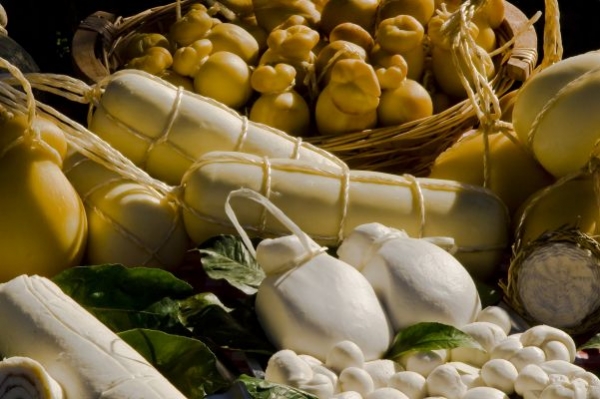La Penisola Sorrentina manifesta la sua capacità di eccellere – oltre che nella coltivazione – anche in campo eno-gastronomico grazie alla produzione di prodotti tipici lavorati, tra i quali spicca il cosiddetto “provolone del monaco”. Questo formaggio locale a pasta filata dura ha un sapore squisito e un certo grado di piccantezza, che varia in base alla stagionatura tra i sei e i diciotto mesi.
È un formaggio di dimensioni variabili e può arrivare ad un peso che oscilla tra i cinque e i dieci chilogrammi. Tipica è la forma a pera o fiasco – il che lo differenzia dal caciocavallo classico – per la mancanza della testina a chiusura della sommità.
Si presenta con una crosta dura e spessa circa mezzo centimetro, di colore giallo dorato.
Si tratta di un formaggio dal sapore inconfondibile e che viene realizzato ancora oggi nel rispetto delle antichissime tecniche di lavorazione. Per questa ragione, infatti, il provolone del monaco della Penisola Sorrentina è al centro di alcune leggende: in primis quella legata al significato del suo stesso nome.
Origine del nome
A dispetto delle apparenze, questo prodotto caseario della Penisola Sorrentina e dei Monti Lattari, non è stato ideato dai monaci.
L’ idea di chiamarlo così, in realtà, è dovuto alla somiglianza delle bisacce usate dai commercianti locali che trasportavano questo formaggio ricorrendo all’utilizzo di sacche comunemente portate in spalla dai monaci questuanti.
Un’altra ipotesi, poi, vorrebbe che il nome sia stato coniato osservando i pastori provenienti dai Monti Lattari che lo trasportavano. Proprio questi ultimi, infatti, per ripararsi dall\’ umidità del mare e della notte, si ricoprivano con una grande mantella che ricorda il saio dei monaci.
Al di là degli aspetti leggendari, il provolone del monaco è considerato inimitabile per il sapore e le sue proprietà organolettiche.
La pasta compatta e di colore bianco crema, presenta rare fessurazioni lacrimanti.
Infatti, al momento del primo taglio della degustazione, in conseguenza del passaggio dal freddo naturale del luogo di stagionatura alla temperatura ambiente, si produce la tipica \”lacrima\”, frutto della condensa del grasso presente nella pasta lattea.
Quando e come si produce
Il Provolone del monaco Viene prodotto da gennaio a marzo. La produzione è legata alla razza di mucca detta “agerolese“: la qualità del latte di questa vacca, è la sintesi di tre patrimoni genetici (tra cui la “jersey“).
La produzione di questo caciocavallo prevede l\’impiego di caglio di capretto. Dopo trenta o quaranta minuti, raggiunta a coagulazione a 38 gradi centigradi, si eseguono ripetute rotture della cagliata con la “sassa” (un rudimentale spino di legno), riducendola alla dimensione di chicchi di grano.
Poi si procede alla cottura della pasta ed alla frantumazione della stessa; si lascia spurgare e maturare, quindi si effettua la “filatura“. Quest’operazione è abbastanza complessa: richiede l’intervento di due persone che tirano ed attorcigliano la cagliata come fosse una corda.
Quando la pasta tiene, le si dà la forma; segue l’immersione in salamoia, per un numero di giorni pari ai chili di peso; quindi inizia la stagionatura, che avviene in locali ben areati ed umidi come grotte calcaree o cantine con fondo di terra e pietre laviche.

